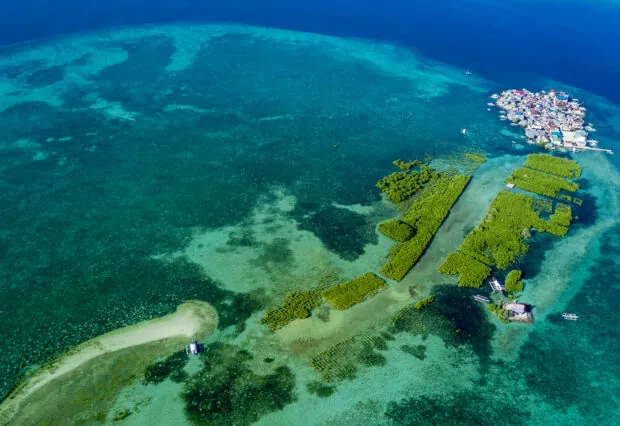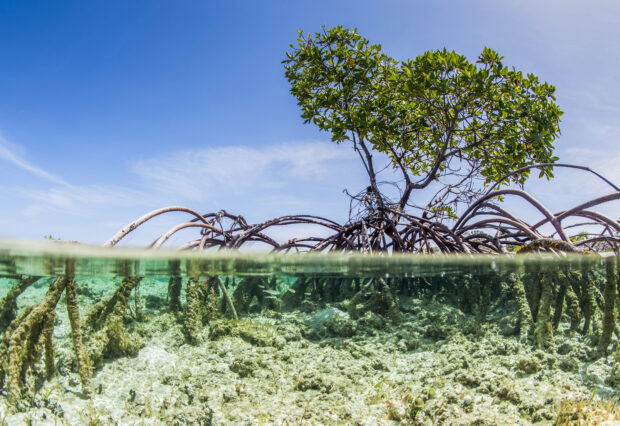A sea change in levels of ocean finance is urgently needed. The only way to achieve this is to take investment and insurance decisions through a blue lens, to ensure the future resilience of coastal communities and the health of the Ocean, and to create a truly sustainable Blue Economy.
Karen Sack, Executive Director of ORRAA, looks at how the forthcoming
United Nations Ocean Conference (UNOC) can energise the finance sector.
Challenge
The Ocean, the planet’s greatest asset, is at Code Red. Heating, pollution, acidification, overfishing and destructive fishing all threaten its health and the biodiversity that millions depend on for food, social resilience and economic security.
The danger we all face as a result, either through physical threat, loss of economic security or reduction in investment earnings, is increasingly recognised. At the One Ocean Conference in France, leaders from over 100 countries agreed to work together swiftly and tangibly to stop the degradation of the Ocean. This was followed by the US$16billion of additional commitments to ocean health made at the Our Ocean Conference in Palau in April.
With the UN’s second Ocean Conference in Lisbon at the end of June fast approaching, we need to ratchet up our efforts.
The Way Forward
The theme of the conference is Save our Ocean, Protect our Future. Activating finance and investment into ocean and coastal natural ecosystems is essential to achieve this and the SDG 14 targets. The ocean community may not have focused on finance before, but we cannot risk avoiding this topic any longer. SDG14 is the least invested in Development Goal[1] and less that one per cent of climate finance is invested into the Ocean.
The Ocean Risk and Resilience Action Alliance (ORRAA) was established to bring together key stakeholders to drive a sea-change in ocean investment. Married with the right financial architecture, which places safeguards and guardrails around the types of ocean investment, a truly sustainable Blue Economy can be created to provide long term food security, stabilise livelihoods, regenerate biodiversity and build the adaptive capability and resilience of coastal communities as well as provide the bankable returns investors require.
ORRAA recently joined with the think tank Europe Jacques Delors to produce Delivering a Sea Change: A G7 Ocean Finance Deal. Some of the recommendations might seem to be a world away from concerns about marine biodiversity, oceanic heatwaves or the potential impacts of deep seabed mining, but without them, the way that the finance community invests over the next decade, could reinforce business as usual and continue the ocean’s trajectory of decline.
The paper, co-authored by leading financiers, scientists and policymakers from G7 countries, focused on how these leaders could put financial muscle behind what has been termed the eighth largest economy in the world: the Ocean. Contributors ranged from Claudio de Sanctis, Head of Deutsche Bank’s International Private Bank, Pascal Lamy, President of the Paris Peace Forum, Geneviéve Pons, Director General of Europe Jacques Delors, and Professor Anya M. Waite, CEO and Scientific Director of Canada’s Ocean Frontier Institute.
The report identified a four-point ocean finance action plan.
Four Point Action Plan
1. Reporting, disclosure and exclusion.
The financial sector is increasingly applying ESG (Environmental, Social and Governance) objectives to help address the biodiversity crisis and protect nature. Within this, we need to apply agreed guardrails and safeguards that ensure the protection of marine and coastal resources progressively, consistently, and globally, including the exclusion of activities that are climate harmful and biodiversity negative. In particular, ocean-related metrics should be integrated into the outcomes of the Taskforce on Nature-related Disclosures (TNFD) and the TNFD must be aligned with the Taskforce on Climate-related Financial Disclosures (TCFD).
The Ocean, the planet’s greatest asset, is at Code Red. Heating, pollution, acidification, overfishing and destructive fishing all threaten its health and the biodiversity that millions depend on for food, social resilience and economic security.
2. Principles and standards for a sustainable ocean economy.
We need agreed quality standards and verification processes for sustainable blue finance products from loans to bonds to credits. The United Nations Environment Programme’s Finance Initiative’s (UNEP-FI) Sustainable Blue Economy Financing Principles and the UNFCCC’s Ocean and Climate Change Dialogue can both help to close knowledge gaps and boost ocean-climate action.
3. Cooperation, Engagement, and Public-Private Partnerships.
Governments need to take policy and regulatory leadership and help to facilitate private sector engagement into projects both through direct support and blended finance, and through risk reduction and transfer tools like insurance. Developing a broader global ocean finance architecture that supports a rapid transition and provides entry points for ocean technology, innovation for sustainability and for significant investments into the protection of blue natural capital within and beyond national borders, is key.
4. Financing a Sea Change.
Investments are needed in early-stage, nature-positive and ocean-science-based opportunities, in profitable and job-creation activities respectful of biodiversity, as well as through large-scale investment into coastal blue infrastructure that is zero-carbon, resilient, equitable, biodiversity positive and implements Nature-based Solutions.
The scale and urgency of the challenges posed by ocean-derived risks calls for a transformative and global response. The transition to a sustainable blue economy requires a concerted finance approach with increased public and private funding such as those being developed through ORRAA, and particularly the Sea Change Impact Finance Facility (SCIFF).
There is no time to lose. This much delayed UN Ocean Conference is an opportunity to energise action.
Lisbon can point us towards a more resilient coastal and ocean investment model: one that protects and restores marine life, secures the future well-being of coastal communities, reduces the risk of falling portfolio values and stranded assets, and achieves sustainable and long-term returns for those investing in the ocean’s natural assets. It is high-time that we chart this course forward, together.
[1] See The Economist (2022): ODA financial flows for the SDGs




